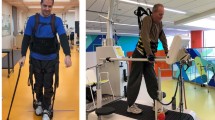Abstract
Objectives:
The aim of this study was to evaluate the effect of a powered gait orthosis (PGO) on the temporal–spatial parameters and kinematics of walking in both healthy participants and persons with spinal cord injury (SCI) using three-dimensional motion analysis to facilitate further development of such devices.
Methods:
Kinematics and temporal spatial data were obtained from three healthy participants and four persons with SCI who walked using the same design of PGO.
Results:
Walking speed was reduced by 28% and step length by 29% in healthy individuals when walking with PGO compared with normal walking and that recorded for persons with SCI was approximately one-third that of normal walking. There were significant differences in hip and knee joint ranges of motion in comparison between walking with PGO in healthy participants and walking with PGO in persons with SCI.
Conclusion:
Walking with a PGO by healthy participants significantly reduced critical gait parameters, and further development work is needed to produce a more effective device to match closely the gait parameters of normal walking by healthy participants. Significant differences between normal walking and that evidenced with the PGO by both healthy participants and persons with SCI were detected.
Similar content being viewed by others
Log in or create a free account to read this content
Gain free access to this article, as well as selected content from this journal and more on nature.com
or
References
Arazpour M, Bani MA, Hutchins SW . Reciprocal gait orthoses and powered gait orthoses for walking by spinal cord injury patients. Prosth Orth Int 2013; 37: 14–21.
Arazpour M, Bani M, Hutchins S, Jones R . The physiological cost index of walking with mechanical and powered gait orthosis in patients with spinal cord injury. Spinal Cord 2013; 51: 356–359.
Bernardi M, Canale I, Castellano V, Di Filippo L, Felici F, Marchetti M . The efficiency of walking of paraplegic patients using a reciprocating gait orthosis. Spinal Cord 1995; 33: 409–415.
Massucci M, Brunetti G, Piperno R, Betti L, Franceschini M . Walking with the advanced reciprocating gait orthosis (ARGO) in thoracic paraplegic patients: energy expenditure and cardiorespiratory performance. Spinal Cord 1998; 36: 223–227.
Yang L, Condie D, Granat M, Paul J, Rowley D . Effects of joint motion constraints on the gait of normal subjects and their implications on the further development of hybrid FES orthosis for paraplegic persons. J Biomech 1996; 29: 217–226.
Dall P, Müller B, Stallard I, Edwards J, Granat M . The functional use of the reciprocal hip mechanism during gait for paraplegic patients walking in the Louisiana State University reciprocating gait orthosis. Prosth Orth Int 1999; 23: 152–162.
Hirokawa S, Grimm M, Solomonow M, Baratta R, Shoji H, D'ambrosia R . Energy consumption in paraplegic ambulation using the reciprocating gait orthosis and electric stimulation of the thigh muscles. Arch Phys Med Rehab 1990; 71: 687.
Kawashima N, Taguchi D, Nakazawa K, Akai M . Effect of lesion level on the orthotic gait performance in individuals with complete paraplegia. Spinal Cord 2006; 44: 487–494.
Audu ML, To CS, Kobetic R, Triolo RJ . Gait evaluation of a novel hip constraint orthosis with implication for walking in paraplegia. IEEE Trans Neural Syst Rehab Eng 2010; 18: 610–618.
Arazpour M, Chitsazan A, Hutchins SW, Ghomshe FT, Mousavi ME, Takamjani EE et al. Design and simulation of a new powered gait orthosis for paraplegic patients. Prosth Orth Int 2012; 36: 125–130.
Arazpour M, Chitsazan A, Hutchins SW, Mousavi ME, Takamjani EE, Ghomshe FT et al. Evaluation of a novel powered gait orthosis for walking by a spinal cord injury patient. Prosth Orth Int 2012; 36: 239–246.
Arazpour M, Chitsazan A, Hutchins SW, Ghomshe FT, Mousavi ME, Takamjani EE et al. Evaluation of a novel powered hip orthosis for walking by a spinal cord injury patient: a single case study. Prosth Orth Int 2012; 36: 105–112.
Rasmussen AA, Smith KM, Damiano DL . Biomechanical evaluation of the combination of bilateral stance-control knee–ankle–foot orthoses and a reciprocating gait orthosis in an adult with a spinal cord injury. J Prosth Ortho 2007; 19: 42.
Johnson WB, Fatone S, Gard SA . Walking mechanics of persons who use reciprocating gait orthoses. J Rehab Res Dev 2009; 46: 435–446.
Kang S, Ryu J, Moon I, Kim K, Mun M (eds).. Walker Gait Analysis of Powered Gait Orthosis for Paraplegic. World Congress on Medical Physics and Biomedical Engineering 2006. Springer: Berlin. 2007.
Leung AKL, Wong AFY, Wong ECW, Hutchins SW . The physiological cost index of walking with an isocentric reciprocating gait orthosis among patients with T12–L1 spinal cord injury. Prosth Orth Int 2009; 33: 61–68.
Ijzerman MJ, Baardman G, van't Hof MA, Boom HB, Hermens HJ, Veltink PH . Validity and reproducibility of crutch force and heart rate measurements to assess energy expenditure of paraplegic gait. Arch Phys Med Rehab 1999; 80: 1017–1023.
Author information
Authors and Affiliations
Corresponding author
Ethics declarations
Competing interests
The authors declare no conflict of interest.
Rights and permissions
About this article
Cite this article
Arazpour, M., Mehrpour, S., Bani, M. et al. Comparison of gait between healthy participants and persons with spinal cord injury when using a powered gait orthosis-a pilot study. Spinal Cord 52, 44–48 (2014). https://doi.org/10.1038/sc.2013.139
Received:
Revised:
Accepted:
Published:
Issue date:
DOI: https://doi.org/10.1038/sc.2013.139


